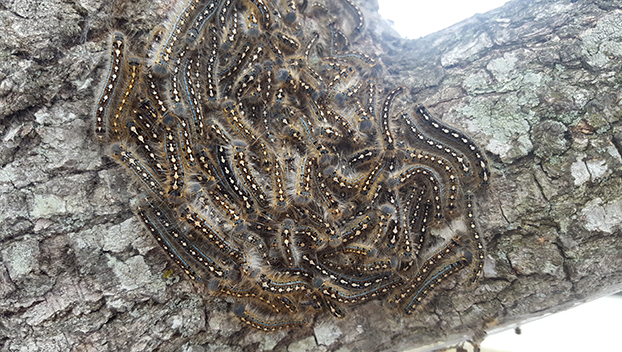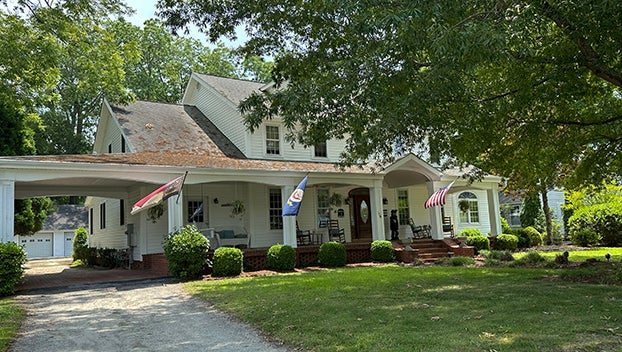How to deal with forest tent caterpillars
Published 12:12 pm Thursday, April 22, 2021

- Forest tent caterpillars are often seen in clusters and can mean certain death for a smaller tree. (Photo submitted by Gene Fox)
|
Getting your Trinity Audio player ready...
|
This is something I haven’t had a call about since 2017. The client sent an email with masses of “worms” on their tree. The obvious question was two parts in nature, “What is it and how do I kill it?”
These are forest tent caterpillars. This is the larva stage of the forest tent caterpillar moth. They lay eggs in masses between 100 and 350 eggs. The caterpillars hatch in early spring as the leaves are just beginning to unfold. They are all black and about 1/8” in length. In the early part of the life stage, they will congregate in the upper portion of the tree. They stay together and move in a line up and down the tree playing follow the leader. The leaders of the lines will spin silk for the others to follow.
Unlike other tent caterpillar species that spin tents in conspicuous parts of the tree like the crotch angles, forest tent caterpillars spin webbing material in a mat on the bark where they congregate to molt or rest. The caterpillars will go through 5 life stages or molts, each time emerging with more color. As they get older, they tend to congregate in the lower portion of the tree, this is when we typically notice them. By this time, they are about two inches in length and ready to enter their cocoon. Many species of insects and/or caterpillars are host specific but these are not. Although they are most often found on oaks and sweet gums, they can be found on a range of hosts from cherry to ash to birch.
Forest tent caterpillars, in high enough populations, can completely defoliate a tree. If the tree is otherwise unstressed, it will be fine and new leaves will emerge throughout the season. If, however, the tree is under other stresses, it may not have the energy to push out new leaves. Once the tree is defoliated, they move on to shrubs and even vegetable crops to sustain their appetites.
If the caterpillar damage is seen two or three years in a row, the tree should be treated for them. Smaller trees that cannot withstand the damage of defoliation should be treated as well. When the caterpillars are smaller, Bacillus thuringiensis B.t. can be used. This is a biological insecticide that is approved for organic use. It is very effective on smaller caterpillars but not bad on beneficial insects such as ladybugs.
I am also fielding many calls on large patches in centipedegrass. This is a disease that can cause large patches of dead turf which are highly visible during green-up. These spots will begin as circles 12” to 24” in size, often unnoticed the first few years until they grow in size. The disease is active in the fall when soil temperatures drop so treating now is likely a waste of time and money. I know it has been chilly the last couple of nights but our soil temperatures are already in the 70°’s. This is a mark that took us until Memorial Day last year!
Take pictures of the area for reference next fall. Treat with fungicide in centipedegrass when soil temperatures fall below 80° for five consecutive days (late August-early September). The fungicides should have large patches on the label. These are typically a mix of fungicides containing the active ingredients azoxystrobin, chlorothalonil, and/or propiconazole. Many of these are available to homeowners without a pesticide license. Most labels recommend two applications in the fall and one in the spring to prevent the disease. Prepare a solution and/or apply according to label instructions for your product.
Our fifth Lunch & Learn was this past Thursday. The topic was on how to convert your bucket over to a summer bucket. Next Thursday, April 29, will be our last session and will focus on integrated pest management for warm season crops. You can register for this series by visiting go.ncsu.edu/saladinabucket. The program should take 15-20 minutes leaving 10-15 minutes for questions.
The master gardeners will be back at the farmers market this season. If you are having trouble in your garden or just have a question, please come by and ask a master gardener. Our Greenline is open for business on Mondays and Wednesdays from 10 a.m. to 12 p.m. Call in during this time to speak to a master gardener about your plants. Learn more on Facebook at the Blacklands Area Horticulture page or visit the Extension Office located at 155 Airport Road in Washington, NC.
Gene Fox is the area consumer horticulture agent with North Carolina Cooperative Extension.





